Datasheet
Year, pagecount:2014, 5 page(s)
Language:English
Downloads:2
Uploaded:March 04, 2019
Size:543 KB
Institution:
-
Comments:
Attachment:-
Download in PDF:Please log in!
Comments
No comments yet. You can be the first!Most popular documents in this category
Content extract
Source: http://www.doksinet Global Business – 2014 – Ranim Helwani Chapter 5 – Creating Worldwide Innovation and Learning Exploiting Cross-‐Border Knowledge Management Transnational innovation process: Sensing an emerging consumer trend in one country, link it to a new technology or capability that it has in another, develop a creative new product or service in a third then diffuse that innovation rapidly around the world. Competing MNEs are required to build layers of competitive advantage: capture scale efficiencies, local market responsiveness and world wide learning capability. à
There is a fast growing investment in knowledge-‐based assets reflected in the increase in value of intangible assets. Traditionally: MNEs regarded their stock of domestically accumulated knowledge and expertise as an asset they could sell into foreign markets. Global market seen to generate additional revenue Today: MNEs collect world-‐class knowledge by using worldwide presence to maintain and expand its innovative lead à global market as source of innovation and learning. à subsidiaries take on new roles: must become sensors of new market trends or technological development, must attract scarce
talent and expertise, must exploit resulting innovations worldwide Problem: many modern companies are constructed in a way that constrains and sometimes kills the natural human instinct of learning from each other. How to capture, develop, leverage and exploit knowledge to support effective worldwide innovation and learning? Traditional Innovation: Central and Local Models The Center-‐for-‐Global Innovation Model -‐ new opportunity sensed in home country -‐ resources and capabilities of parent company used to create new product or process -‐ one main R&D center -‐ role of
subsidiaries was to introduce innovation into local markets à dominates in global and international companies The Local-‐for-‐Local Innovation Model -‐ relies on subsidiary based knowledge development -‐ subsidiaries respond to perceived local opportunities -‐ use their own resources and capabilities and create innovative responses à dominates in multinational companies à First challenge regardless of model is how to make cross-‐border innovation effective. à both models have limitations and their innovation processes were rarely sufficient, esp. for companies in fast-‐changing,
knowledge-‐intensive industries like electronics, biotech etc. à Need for Transnational innovation capability. Making Central Innovations Effective -‐ Japanese companies become champions of centralized innovation (global strategy) -‐ Greatest risk of that strategy: market insensitivity and the accompanying resistance of local subsidiary managers to what they may view as inappropriate new products and processes Source: http://www.doksinet Global Business – 2014 – Ranim Helwani Successful companies develop three important capabilities to managing the center-‐for-‐global process: 1. Gaining Subsidiary
Input: Multiple Linkages Problem: those at the centralized operations (headquarter) may not understand market needs and those in the subsidiaries may not be committed to a implement a central innovation. Solution: build multiple linkages between headquarters and overseas subsidiaries à for central managers better understanding of country-‐level needs and for subsidiary managers greater access to involvement in centralized decisions and tasks 2. Responding to National Needs: Market Mechanisms à ensuring that all functional tasks are linked to market needs à need to create an integrative process to
ensure that headquarter managers are not sheltered from the constraints and demands felt my managers on the front end. à Use of “Internal Market Mechanisms”: directs and regulates central activities. -‐ ie. holding meetings with all overseas subsidiaries where they negotiate for features and prices of products for the upcoming year. à Internal market connects consumer demand to technological Innovation. 3. Managing Responsibility Transfer: Personnel Flow à need to integrate value chain functions by managing the transfer of responsibilities across development, production and marketing . à
more difficult for the central than for the local-‐for-‐local innovation process, as integration and cross-‐functional coordination is facilitated by smaller size and proximity Integrative systems: rely heavily on the transfer of people -‐ ie moving engineers to line management positions; ensuring knowledge about project moves with individual. -‐ Or other way round: injecting direct production expertise into development team à additionally facilitates the transfer of the project after its design is completed. Making Local Innovations Efficient à local-‐for-‐local innovations often suffer from
needless differentiation and “reinvention of the wheel” – caused by resource-‐rich subsidiaries trying to protect their independence Successful companies developed three abilities to be more efficient: 1. Empowering Local Management à prerequisites for local innovation is the dispersal of organizational assets and resources and the delegation of authority to the subsidiary in order to take initiative in creating new processes. à decentralizing à Need to transfer assets and resources and empower their subsidiary operations to make them creative and entrepreneurial 2. Linking Local Managers to Corporate
Decision-‐Making Processes à need to make linkages to corporate decision-‐making processes to make the local-‐for-‐local tasks effective for the company as a whole. i.e: Career assignment patterns of entrepreneurial expatriates; assigning them to national operations to create organizational relationships, shared identity and a strong bond à should not see themselves as parent-‐company executives temporarily on assignment in foreign company. Source: http://www.doksinet Global Business – 2014 – Ranim Helwani 3. Integrating Subsidiary Functions à local innovativeness and decentralized
federation is enhanced when strong cross-‐functional integration within each national operation exist. -‐ ie. Phillips: Integration at three levels: o “article team”: create product policies, annual sales plans and budgets o product level – meeting of representatives to review results § retaining control and conflict resolution to facilitate rapid responses to initiatives and ideas generated at local level o subsidiary-‐level coordination forum – senior management committee (SMC) § local board, ensure autonomy and responsibility for own strategies of national operation Transnational Innovation: Locally Leveraged,
Globally Linked à Traditional models have evolved into two new processes: Transnational innovation models that are locally leveraged and globally linked. Locally Leveraged innovation: ensuring that special resources and capabilities of each national subsidiary are available not only to that entity but also to other MNE units worldwide. Globally linked innovation: pools resources and capabilities of many different units, both parent and subsidiary level to create and manage an activity jointly. Allows taking market intelligence developed in one part, link it to a specialized expertise in another part and
to a scarce resource in a third and then eventually diffuse new product worldwide. à They are seen as supplements not replacements to the traditional innovation processes. Challenge today: organization needs to facilitate all four processes of cross-‐border innovation and learning simultaneously – under stand power and limitations of each. Making Transnational Processes Feasible Need to overcome two problems in order to build portfolio of innovative processes to drive worldwide learning: 1. Avoid pitfalls associated with each processes 2. Overcome the organizational contradictions among them
Simplifying assumptions Successful transnational innovations -‐ treating all businesses, functions and -‐ systematically differentiates tasks and subsidiaries in the same way, responsibilities assuming they should be uniform and symmetrical -‐ seeking organizational clarity by -‐ build interdependence among the assuming headquarters-‐subsidiary different units of the companies relationships to be based on clear and unambiguous patterns of dependence and independence -‐ assuming that corporate management -‐ search for complex mechanisms to has a responsibility to exercise decision coordinate and coopt the differentiated
making and control uniformly and interdependent organizational units into sharing a visions of the Source: http://www.doksinet Global Business – 2014 – Ranim Helwani company’s strengths From Symmetry to Differentiation -‐ recognition that different businesses faced different demands for integration and responsiveness. -‐ Differences in local tastes and national cultures impede the degree of standardization, coordination and integration for each subsidiary unit. -‐ Decentralization became difficult to support: national subsidiaries chose to develop, manage and market the products that they thought
appropriate à inefficient à Need to differentiate the way they managed businesses and functions, as well as management of diverse geographic operations. Have differing external environments and internal constraints à Symmetric treatment could constrain strategic capabilities à move from uniformly decentralized federation to much more differentiated one: by product, then by function and finally by geography. From Dependence of Independence to Interdependence Decentralized federation: subsidiary independent Centralized hub federation: strongly dependent on parent company for resources & capabilities à
need to develop transnational innovation requires to build interdependent relationships àadding layers of administrative mechanisms to foster cooperation were disappointing Two requirements for an effective interdependent organization to exist: 1. Develop the integrated network (CH4): the interdependent configuration of dispersed and specialized resources à frames new roles and responsibilities: all subsidiary companies will take sensing and scanning roles to detect consumer trends, technological advances and competitive activities that may trigger a new opportunity or threat. 2. Build interunit integration mechanisms to ensure that
task interdependencies lead to the benefits of synergy rather than the paralysis of conflict. à requires good interpersonal relationships among managers of different units -‐ movement of people strongest mechanism to breaking local dogmas – both learn and provide expertise -‐ exchange often-‐divergent objectives in national company’s board meetings. From Simple Control to Flexible Coordination à simplifying assumptions of organizational symmetry and dependence/independence allowed management processes to be simple à growing differentiation and interdependence lead to explosion of issues that had to be
linked and integrated à need to supplement existing processes with more subtle and sophisticated ones. Need to coordinate three different flows among the interdependent organizational units Type of Flow Management Process Flow of Goods à Best achieved through formalization -‐ sourcing raw materials and other -‐ managed effectively at lover levels of supplies organizations through clear procedures and -‐ linking and distributing strong systems; standardize as much as possible Flow of financial, human and technological à Best achieved through centralization resources Best controlled at
corporate level to get a good Source: http://www.doksinet Global Business – 2014 – Ranim Helwani Flow of information and knowledge -‐ raw data to analyzed information, expertise overview of total situation to make critical decisions à Best achieved through socialization most difficult task, tacit knowledge impossible to be controlled through formal systems or centralized controls à sensitize local managers to broader corporate objectives and priorities, ensuring they are exposed to the relevant knowledge through frequent contacts; organizational forums; foster free exchange of
information and cross-‐unit learning à companies use a variety of coordinative mechanisms à best way to capture innovation is sometimes to move people and sometimes to move or exchange information. à one-‐size-‐fits-‐all strategy will not work on large MNE à no single right way of managing innovation process in an MNE: Each company has unique administrative heritage that it cannot and should not give up. But there are principles (differentiation of roles, interdependence and modes of control) that underpin the development of an effective transnational organization.
There is a fast growing investment in knowledge-‐based assets reflected in the increase in value of intangible assets. Traditionally: MNEs regarded their stock of domestically accumulated knowledge and expertise as an asset they could sell into foreign markets. Global market seen to generate additional revenue Today: MNEs collect world-‐class knowledge by using worldwide presence to maintain and expand its innovative lead à global market as source of innovation and learning. à subsidiaries take on new roles: must become sensors of new market trends or technological development, must attract scarce
talent and expertise, must exploit resulting innovations worldwide Problem: many modern companies are constructed in a way that constrains and sometimes kills the natural human instinct of learning from each other. How to capture, develop, leverage and exploit knowledge to support effective worldwide innovation and learning? Traditional Innovation: Central and Local Models The Center-‐for-‐Global Innovation Model -‐ new opportunity sensed in home country -‐ resources and capabilities of parent company used to create new product or process -‐ one main R&D center -‐ role of
subsidiaries was to introduce innovation into local markets à dominates in global and international companies The Local-‐for-‐Local Innovation Model -‐ relies on subsidiary based knowledge development -‐ subsidiaries respond to perceived local opportunities -‐ use their own resources and capabilities and create innovative responses à dominates in multinational companies à First challenge regardless of model is how to make cross-‐border innovation effective. à both models have limitations and their innovation processes were rarely sufficient, esp. for companies in fast-‐changing,
knowledge-‐intensive industries like electronics, biotech etc. à Need for Transnational innovation capability. Making Central Innovations Effective -‐ Japanese companies become champions of centralized innovation (global strategy) -‐ Greatest risk of that strategy: market insensitivity and the accompanying resistance of local subsidiary managers to what they may view as inappropriate new products and processes Source: http://www.doksinet Global Business – 2014 – Ranim Helwani Successful companies develop three important capabilities to managing the center-‐for-‐global process: 1. Gaining Subsidiary
Input: Multiple Linkages Problem: those at the centralized operations (headquarter) may not understand market needs and those in the subsidiaries may not be committed to a implement a central innovation. Solution: build multiple linkages between headquarters and overseas subsidiaries à for central managers better understanding of country-‐level needs and for subsidiary managers greater access to involvement in centralized decisions and tasks 2. Responding to National Needs: Market Mechanisms à ensuring that all functional tasks are linked to market needs à need to create an integrative process to
ensure that headquarter managers are not sheltered from the constraints and demands felt my managers on the front end. à Use of “Internal Market Mechanisms”: directs and regulates central activities. -‐ ie. holding meetings with all overseas subsidiaries where they negotiate for features and prices of products for the upcoming year. à Internal market connects consumer demand to technological Innovation. 3. Managing Responsibility Transfer: Personnel Flow à need to integrate value chain functions by managing the transfer of responsibilities across development, production and marketing . à
more difficult for the central than for the local-‐for-‐local innovation process, as integration and cross-‐functional coordination is facilitated by smaller size and proximity Integrative systems: rely heavily on the transfer of people -‐ ie moving engineers to line management positions; ensuring knowledge about project moves with individual. -‐ Or other way round: injecting direct production expertise into development team à additionally facilitates the transfer of the project after its design is completed. Making Local Innovations Efficient à local-‐for-‐local innovations often suffer from
needless differentiation and “reinvention of the wheel” – caused by resource-‐rich subsidiaries trying to protect their independence Successful companies developed three abilities to be more efficient: 1. Empowering Local Management à prerequisites for local innovation is the dispersal of organizational assets and resources and the delegation of authority to the subsidiary in order to take initiative in creating new processes. à decentralizing à Need to transfer assets and resources and empower their subsidiary operations to make them creative and entrepreneurial 2. Linking Local Managers to Corporate
Decision-‐Making Processes à need to make linkages to corporate decision-‐making processes to make the local-‐for-‐local tasks effective for the company as a whole. i.e: Career assignment patterns of entrepreneurial expatriates; assigning them to national operations to create organizational relationships, shared identity and a strong bond à should not see themselves as parent-‐company executives temporarily on assignment in foreign company. Source: http://www.doksinet Global Business – 2014 – Ranim Helwani 3. Integrating Subsidiary Functions à local innovativeness and decentralized
federation is enhanced when strong cross-‐functional integration within each national operation exist. -‐ ie. Phillips: Integration at three levels: o “article team”: create product policies, annual sales plans and budgets o product level – meeting of representatives to review results § retaining control and conflict resolution to facilitate rapid responses to initiatives and ideas generated at local level o subsidiary-‐level coordination forum – senior management committee (SMC) § local board, ensure autonomy and responsibility for own strategies of national operation Transnational Innovation: Locally Leveraged,
Globally Linked à Traditional models have evolved into two new processes: Transnational innovation models that are locally leveraged and globally linked. Locally Leveraged innovation: ensuring that special resources and capabilities of each national subsidiary are available not only to that entity but also to other MNE units worldwide. Globally linked innovation: pools resources and capabilities of many different units, both parent and subsidiary level to create and manage an activity jointly. Allows taking market intelligence developed in one part, link it to a specialized expertise in another part and
to a scarce resource in a third and then eventually diffuse new product worldwide. à They are seen as supplements not replacements to the traditional innovation processes. Challenge today: organization needs to facilitate all four processes of cross-‐border innovation and learning simultaneously – under stand power and limitations of each. Making Transnational Processes Feasible Need to overcome two problems in order to build portfolio of innovative processes to drive worldwide learning: 1. Avoid pitfalls associated with each processes 2. Overcome the organizational contradictions among them
Simplifying assumptions Successful transnational innovations -‐ treating all businesses, functions and -‐ systematically differentiates tasks and subsidiaries in the same way, responsibilities assuming they should be uniform and symmetrical -‐ seeking organizational clarity by -‐ build interdependence among the assuming headquarters-‐subsidiary different units of the companies relationships to be based on clear and unambiguous patterns of dependence and independence -‐ assuming that corporate management -‐ search for complex mechanisms to has a responsibility to exercise decision coordinate and coopt the differentiated
making and control uniformly and interdependent organizational units into sharing a visions of the Source: http://www.doksinet Global Business – 2014 – Ranim Helwani company’s strengths From Symmetry to Differentiation -‐ recognition that different businesses faced different demands for integration and responsiveness. -‐ Differences in local tastes and national cultures impede the degree of standardization, coordination and integration for each subsidiary unit. -‐ Decentralization became difficult to support: national subsidiaries chose to develop, manage and market the products that they thought
appropriate à inefficient à Need to differentiate the way they managed businesses and functions, as well as management of diverse geographic operations. Have differing external environments and internal constraints à Symmetric treatment could constrain strategic capabilities à move from uniformly decentralized federation to much more differentiated one: by product, then by function and finally by geography. From Dependence of Independence to Interdependence Decentralized federation: subsidiary independent Centralized hub federation: strongly dependent on parent company for resources & capabilities à
need to develop transnational innovation requires to build interdependent relationships àadding layers of administrative mechanisms to foster cooperation were disappointing Two requirements for an effective interdependent organization to exist: 1. Develop the integrated network (CH4): the interdependent configuration of dispersed and specialized resources à frames new roles and responsibilities: all subsidiary companies will take sensing and scanning roles to detect consumer trends, technological advances and competitive activities that may trigger a new opportunity or threat. 2. Build interunit integration mechanisms to ensure that
task interdependencies lead to the benefits of synergy rather than the paralysis of conflict. à requires good interpersonal relationships among managers of different units -‐ movement of people strongest mechanism to breaking local dogmas – both learn and provide expertise -‐ exchange often-‐divergent objectives in national company’s board meetings. From Simple Control to Flexible Coordination à simplifying assumptions of organizational symmetry and dependence/independence allowed management processes to be simple à growing differentiation and interdependence lead to explosion of issues that had to be
linked and integrated à need to supplement existing processes with more subtle and sophisticated ones. Need to coordinate three different flows among the interdependent organizational units Type of Flow Management Process Flow of Goods à Best achieved through formalization -‐ sourcing raw materials and other -‐ managed effectively at lover levels of supplies organizations through clear procedures and -‐ linking and distributing strong systems; standardize as much as possible Flow of financial, human and technological à Best achieved through centralization resources Best controlled at
corporate level to get a good Source: http://www.doksinet Global Business – 2014 – Ranim Helwani Flow of information and knowledge -‐ raw data to analyzed information, expertise overview of total situation to make critical decisions à Best achieved through socialization most difficult task, tacit knowledge impossible to be controlled through formal systems or centralized controls à sensitize local managers to broader corporate objectives and priorities, ensuring they are exposed to the relevant knowledge through frequent contacts; organizational forums; foster free exchange of
information and cross-‐unit learning à companies use a variety of coordinative mechanisms à best way to capture innovation is sometimes to move people and sometimes to move or exchange information. à one-‐size-‐fits-‐all strategy will not work on large MNE à no single right way of managing innovation process in an MNE: Each company has unique administrative heritage that it cannot and should not give up. But there are principles (differentiation of roles, interdependence and modes of control) that underpin the development of an effective transnational organization.
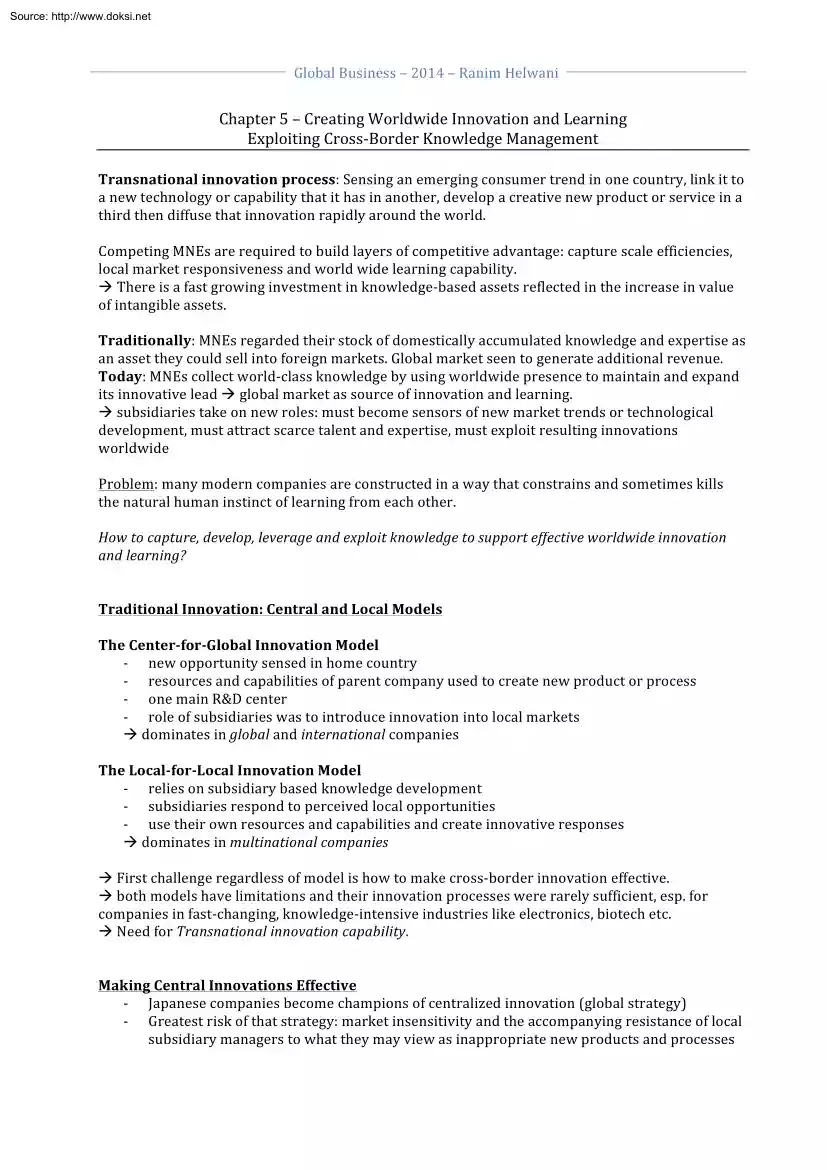
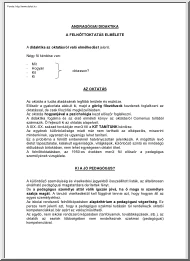
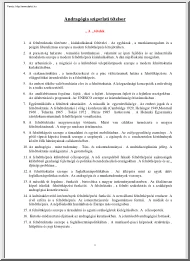
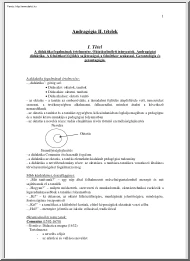
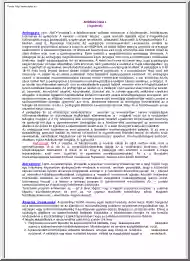
 Just like you draw up a plan when you’re going to war, building a house, or even going on vacation, you need to draw up a plan for your business. This tutorial will help you to clearly see where you are and make it possible to understand where you’re going.
Just like you draw up a plan when you’re going to war, building a house, or even going on vacation, you need to draw up a plan for your business. This tutorial will help you to clearly see where you are and make it possible to understand where you’re going.